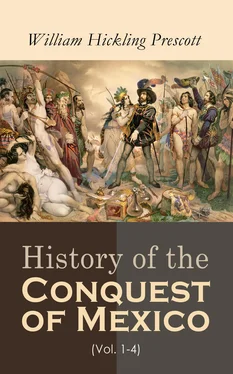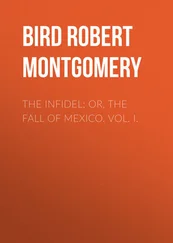Lastly, there was an extraordinary tribunal, called the council of music, but which, differing from the import of its name, was devoted to the encouragement of science and art. Works on astronomy, chronology, history, or any other science, were required to be submitted to its judgment, before they could be made public. This censorial power was of some moment, at least with regard to the historical department, where the wilful perversion of truth was made a capital offence by the bloody code of Nezahualcoyotl. Yet a Tezcucan author must have been a bungler, who could not elude a conviction under the cloudy veil of hieroglyphics. This body, which was drawn from the best-instructed persons in the kingdom, with little regard to rank, had supervision of all the productions of art, and of the nicer fabrics. It decided on the qualifications of the professors in the various branches of science, on the fidelity of their instructions to their pupils, the deficiency of which was severely punished, and it instituted examinations of these latter. In short, it was a general board of education for the country. On stated days, historical compositions, and poems treating of moral or traditional topics, were recited before it by their authors. Seats were provided for the three crowned heads of the empire, who deliberated with the other members on the respective merits of the pieces, and distributed prizes of value to the successful competitors. [282]
Such are the marvellous accounts transmitted to us of this institution; an institution certainly not to have been expected among the aborigines of America. It is calculated to give us a higher idea of the refinement of the people than even the noble architectural remains which still cover some parts of the continent. Architecture is, to a certain extent, a sensual gratification. It addresses itself to the eye, and affords the best scope for the parade of barbaric pomp and splendor. It is the form in which the revenues of a semi-civilized people are most likely to be lavished. The most gaudy and ostentatious specimens of it, and sometimes the most stupendous, have been reared by such hands. It is one of the first steps in the great march of civilization. But the institution in question was evidence of still higher refinement. It was a literary luxury, and argued the existence of a taste in the nation which relied for its gratification on pleasures of a purely intellectual character.
The influence of this academy must have been most propitious to the capital, which became the nursery not only of such sciences as could be compassed by the scholarship of the period, but of various useful and ornamental arts. Its historians, orators, and poets were celebrated throughout the country. [283]Its archives, for which accommodations were provided in the royal palace, were stored with the records of primitive ages. [284]Its idiom, more polished than the Mexican, was, indeed, the purest of all the Nahuatlac dialects, and continued, long after the Conquest, to be that in which the best productions of the native races were composed. Tezcuco claimed the glory of being the Athens of the Western world. [285]
Among the most illustrious of her bards was the emperor himself,—for the Tezcucan writers claim this title for their chief, as head of the imperial alliance. He doubtless appeared as a competitor before that very academy where he so often sat as a critic. Many of his odes descended to a late generation, and are still preserved, perhaps, in some of the dusty repositories of Mexico or Spain. [286]The historian Ixtlilxochitl has left a translation, in Castilian, of one of the poems of his royal ancestor. It is not easy to render his version into corresponding English rhyme, without the perfume of the original escaping in this double filtration. [287]They remind one of the rich breathings of Spanish-Arab poetry, in which an ardent imagination is tempered by a not unpleasing and moral melancholy. [288]But, though sufficiently florid in diction, they are generally free from the meretricious ornaments and hyperbole with which the minstrelsy of the East is usually tainted. They turn on the vanities and mutability of human life,—a topic very natural for a monarch who had himself experienced the strangest mutations of fortune. There is mingled in the lament of the Tezcucan bard, however, an Epicurean philosophy, which seeks relief from the fears of the future in the joys of the present. “Banish care,” he says: “if there are bounds to pleasure, the saddest life must also have an end. Then weave the chaplet of flowers, and sing thy songs in praise of the all-powerful God, for the glory of this world soon fadeth away. Rejoice in the green freshness of thy spring; for the day will come when thou shalt sigh for these joys in vain; when the sceptre shall pass from thy hands, thy servants shall wander desolate in thy courts, thy sons, and the sons of thy nobles, shall drink the dregs of distress, and all the pomp of thy victories and triumphs shall live only in their recollection. Yet the remembrance of the just shall not pass away from the nations, and the good thou hast done shall ever be held in honor. The goods of this life, its glories and its riches, are but lent to us, its substance is but an illusory shadow, and the things of to-day shall change on the coming of the morrow. Then gather the fairest flowers from thy gardens, to bind round thy brow, and seize the joys of the present ere they perish.” [289]
But the hours of the Tezcucan monarch were not all passed in idle dalliance with the Muse, nor in the sober contemplations of philosophy, as at a later period. In the freshness of youth and early manhood he led the allied armies in their annual expeditions, which were certain to result in a wider extent of territory to the empire. [290]In the intervals of peace he fostered those productive arts which are the surest sources of public prosperity. He encouraged agriculture above all; and there was scarcely a spot so rude, or a steep so inaccessible, as not to confess the power of cultivation. The land was covered with a busy population, and towns and cities sprang up in places since deserted or dwindled into miserable villages. [291]
From resources thus enlarged by conquest and domestic industry, the monarch drew the means for the large consumption of his own numerous household, [292]and for the costly works which he executed for the convenience and embellishment of the capital. He filled it with stately edifices for his nobles, whose constant attendance he was anxious to secure at his court. [293]He erected a magnificent pile of buildings which might serve both for a royal residence and for the public offices. It extended, from east to west, twelve hundred and thirty-four yards, and from north to south, nine hundred and seventy-eight. [294]It was encompassed by a wall of unburnt bricks and cement, six feet wide and nine high for one half of the circumference, and fifteen feet high for the other half. Within this enclosure were two courts. The outer one was used as the great market-place of the city, and continued to be so until long after the Conquest,—if, indeed, it is not now. The interior court was surrounded by the council-chambers and halls of justice. There were also accommodations there for the foreign ambassadors; and a spacious saloon, with apartments opening into it, for men of science and poets, who pursued their studies in this retreat or met together to hold converse under its marble porticoes. In this quarter, also, were kept the public archives, which fared better under the Indian dynasty than they have since under their European successors. [295]
Adjoining this court were the apartments of the king, including those for the royal harem, as liberally supplied with beauties as that of an Eastern sultan. Their walls were incrusted with alabasters and richly-tinted stucco, or hung with gorgeous tapestries of variegated feather-work. [296]They led through long arcades, and through intricate labyrinths of shrubbery, into gardens where baths and sparkling fountains were overshadowed by tall groves of cedar and cypress. The basins of water were well stocked with fish of various kinds, and the aviaries with birds glowing in all the gaudy plumage of the tropics. Many birds and animals which could not be obtained alive were represented in gold and silver so skilfully as to have furnished the great naturalist Hernandez with models for his work. [297]
Читать дальше












